Mountain Safety Advisor Heather Morning writes about opportunism and caution on skis
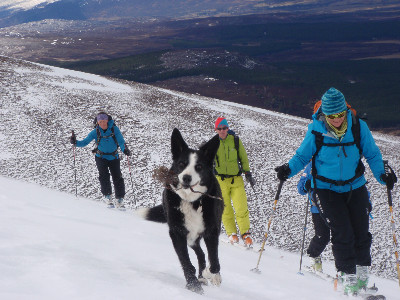
It’s often said that the Scottish ski mountaineer has to be the ultimate opportunist.
The rewards are immense, but the weather and conditions in the mountains so fickle that you have to take your chances when they arise.
There’s a big ‘but’ there though: that opportunism has to be tempered by a clear head and lots of preparation.
Most mountain safety advice will start with information on kit, weather, route ideas etc, but reflecting on why people get into difficulties, based on statistics from Scottish Mountain Rescue, leads me to start this section with us – humans – looking at our behaviour and how we interact with the world around us based on previous life experiences and complex social interactions.
This is known as heuristics. Heuristics feature highly in current avalanche education, but awareness of heuristics and heuristic traps is something that even the most experienced can learn from across all their mountain decision making. Indeed, it is often the most experienced who get caught out by heuristic traps.
The main heuristic traps are listed below and, as we become aware of them, we can take steps to avoid them.
You know the area like the back of your hand and have skied the slope many times. It has always delivered great results and you have never known anyone getting avalanched there – even though you are aware it is a 35-degree angle and on an aspect and altitude showing as a considerable avalanche risk today. You still commit and drop over the edge. But today might just be the day the slope avalanches. Consider another aspect and/or take precautionary measures (one member of the party at a time etc).
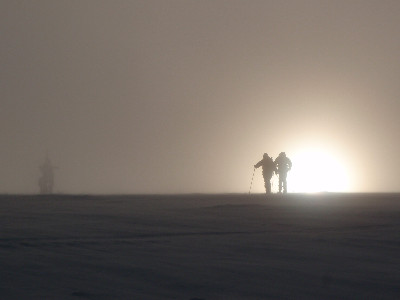
This is also known as being ‘goal orientated’. We have announced we are going to ski that route, gully or summit and after all that time and effort we are so close to achieving our goal. So, we carry on despite all the warning signs around us telling us we should do otherwise: poor visibility, wind slab, fatigue, diminishing daylight... The list is endless. The key is to take the blinkers off, see the bigger picture and make a value judgment not just based on ‘the goal’. A really positive way of not slipping into this trap is to plan several goals for your day, so that as conditions change, your goal can change accordingly.
However comfortable we feel within our group, we are all exposed to peer pressure. No one wants to be the ‘party pooper’ or to be viewed as the weakest link. It is crucial to foster a culture of openness and honesty within your group so everyone can contribute to decision-making and feel comfortable to speak out when they feel that things aren’t right.
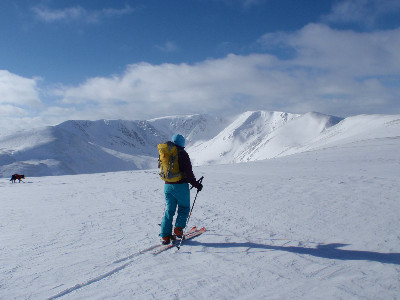
Yep, this one is particularly relevant for Scottish conditions. Some lines only come into condition infrequently and ensuring you are in the right place at the right time with the right people is a juggling act. You might get there and realise that the wind has picked up, forming wind slab on that slope you planned to ski. There’s a lot of pressure to ignore the obvious warning signs that conditions are not right. Combine the scarcity with peer pressure and being goal orientated, and it’s a lethal combination heading towards very bad decisions and potentially serious consequences.
Just because you can see tracks and/or people on the slope does not mean that the line is safe. Just because someone has skied a line before, doesn't mean the line is safe either. Make your own decisions based on the best information available to you at the time.
It’s not unusual within a group that someone will put themselves forward as being more experienced and knowledgeable than others. It might be that this person just has the loudest voice and the least experience. It’s everyone’s responsibility to make sure that they are involved in the decision-making process.
It’s easy to allow safety equipment to cloud your judgement. Does wearing that transceiver make you feel safer and influence your decisions?
In summary, heuristic traps are dangerous, resulting in even the most experienced people defying logic, previous education and common sense in the pursuit of achieving their goals. Awareness of this tendency towards mental shortcuts and guarding against it could save your life.
To be a successful opportunist you have to make sure you’re ready to take those chances when they come. Don’t let those ideal conditions take you by surprise, otherwise you’ll miss the opportunity or end up going out ill-prepared. So keep an eye on weather and conditions as a matter of habit and routine, and make sure all your kit is up to scratch and ready to hand.
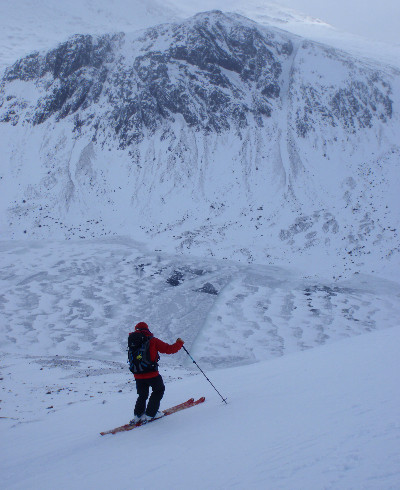
Understanding mountain weather forecasts is essential for making the best decisions both before and during your day out. Combine the weather information with the Scottish Avalanche Information Service bulletin for the area you are interested in. Weather and avalanche are intrinsically linked. Ask yourself what has been happening during the days leading up to your planned adventure as this will indicate where the snow is or is not and what the conditions are likely to be on the aspect you are interested in skiing or boarding.
Mountain weather information service www.mwis.org.uk
Met Office Mountain Forecast www.metoffice.gov.uk/weather/specialist-forecasts/mountain
Scottish Avalanche Information Service www.sais.gov.uk
The SAIS area blogs are a very useful pictorial resource which will help you decide which part of Scotland to head to.
Understanding mountain weather forecasts is essential for making the best decisions both before and during your day out. Combine the weather information with the Scottish Avalanche Information Service bulletin for the area you are interested in. Weather and avalanche are intrinsically linked. Ask yourself what has been happening during the days leading up to your planned adventure as this will indicate where the snow is or is not and what the conditions are likely to be on the aspect you are interested in skiing or boarding.
Mountain weather information service www.mwis.org.uk
Met Office Mountain Forecast www.metoffice.gov.uk/weather/specialist-forecasts/mountain
Scottish Avalanche Information Service www.sais.gov.uk
The SAIS area blogs are a very useful pictorial resource which will help you decide which part of Scotland to head to.
Up-to-date conditions and ideas on route choice can be accessed at
British Backcountry www.facebook.com/groups/Britishbackcountry/
Scottish Backcountry www.facebook.com/ScottishBackcountry
Winter Highland www.facebook.com/Winterhighland
Inverness Backcountry Snowsports Club www.facebook.com/groups/154348047966889/
It is assumed that people reading Scottish Mountaineer will have a working knowledge of the necessary kit and skills required for ski journeys in the mountains. However for information on this check out the snow sport touring pages on the Mountaineering Scotland website www.mountaineering.scot/activities/snowsports-touring which include numerous tips and YouTube videos on kit and on ski technique.
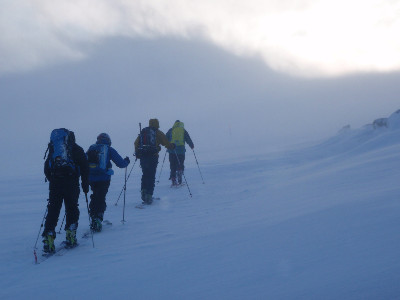
Navigation in winter is more demanding than in summer – and navigation on skis brings more challenges yet – particularly if you find yourself in poor visibility near corniced edges and complete snow cover. It needs to be taken very seriously and a cautious line taken which ensures you keep well away from potentially corniced edges.
Map and compass are essential, with, of course, the well-practiced skills associated with regular use. It might also be prudent to carry some form of electronic back-up in the form of GPS or, as a minimum, the OS Locate app which will provide you with a six-figure grid reference and altitude should you become disorientated. ‘Slope aspect’ is a key tool in the conditions described above.
Judging distance in descent on ski in poor visibility is particularly challenging, and electronic gadgets will help with this. Using a compass effectively when you already have your hands full with ski poles is a skill which needs regular practice. If in doubt about your ability to navigate consider a lower route or choose your days carefully.
Assessing slope angle is essential to aid your avalanche judgement. The following will help you assess the angle of your intended slope.
OS 1:50k map (10m contour interval)
2mm or less between Index contours = a slope of 30 degrees or steeper.
OS 1:25k map (10m contour interval)
4mm or less between Index contours = a slope of 30 degrees or steeper.
Additional navigation information can be viewed at https://www.mountaineering.scot/safety-and-skills/essential-skills/navigation
And winter-specific navigation courses are available, provided by Mountaineering Scotland www.mountaineering.scot/safety-and-skills/courses-and-events/our-courses/winter-navigation-course